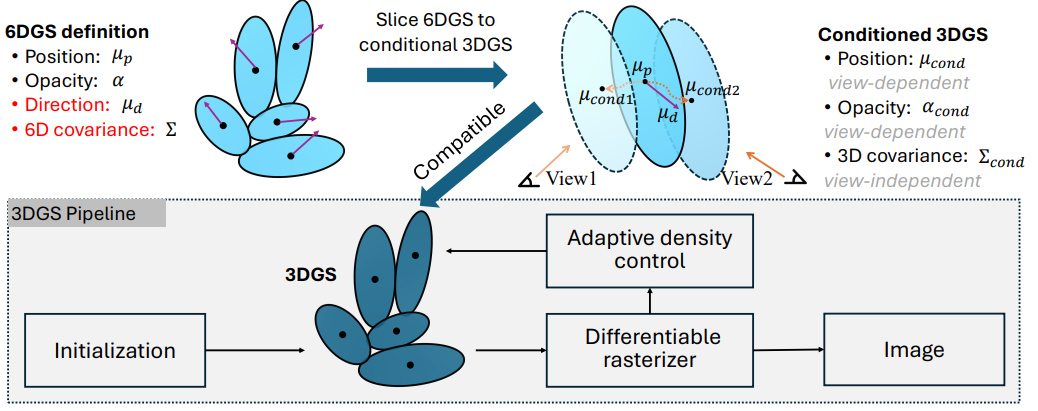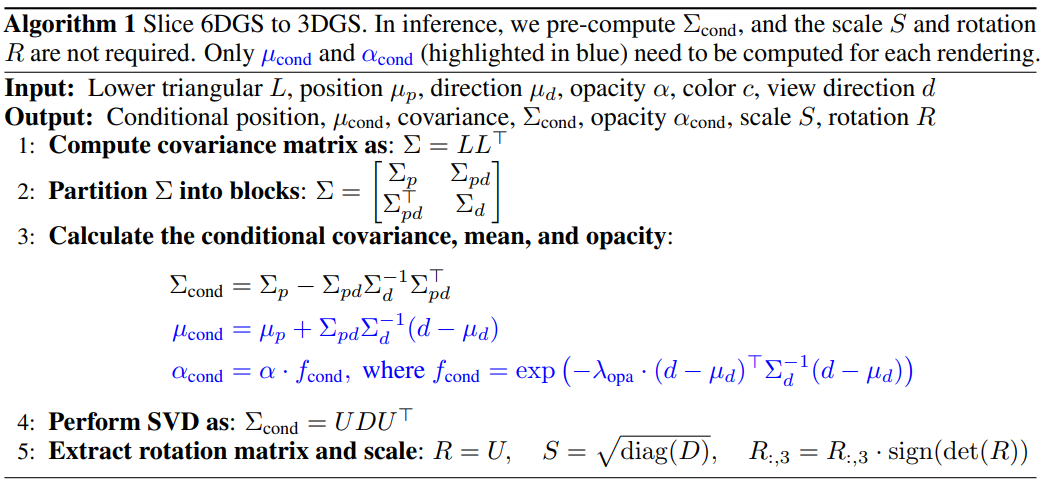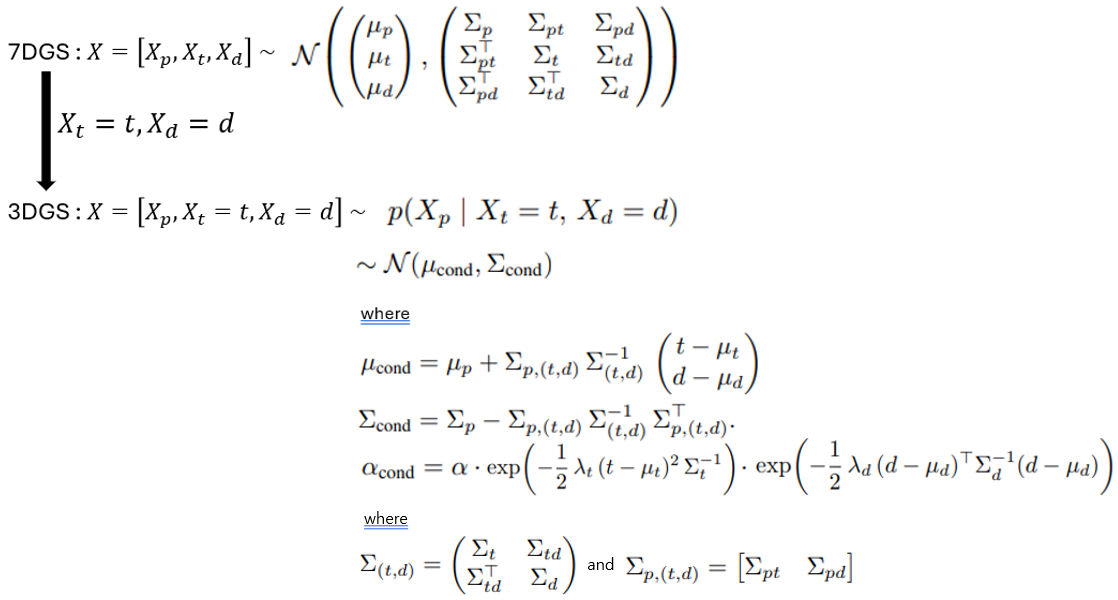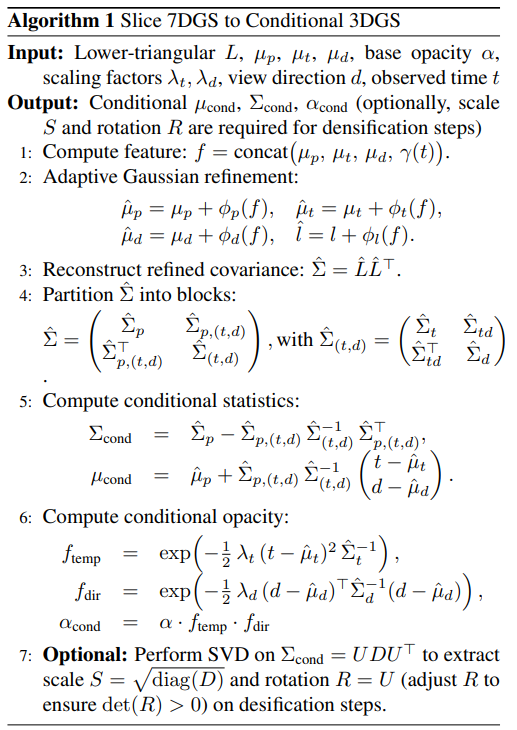7DGS (6DGS)
Unified Spatial-Temporal-Angular Gaussian Splatting
7DGS - Unified Spatial-Temporal-Angular Gaussian Splatting
Zhongpai Gao, Benjamin Planche, Meng Zheng, Anwesa Choudhuri, Terrence Chen, Ziyan Wu
paper :
https://arxiv.org/abs/2503.07946
project website :
https://gaozhongpai.github.io/7dgs/
핵심 요약 :
- 7D = 3D spatial + 3D directional + 1D temporal
- 고정된 covariance를 가진 납작한 anisotropic 3DGS는 view-dependent effect에 취약함.
근데 7DGS는 각기 다른 \(t, d\) 에 맞춰서 학습되었기 때문에 (customized 느낌) view-dependent and dynamic 잘 표현 가능- Adaptive Gaussian Refinement : \(t, d\) 에 따라 7DGS의 param.(spatial, temporal, directional mean and covariance)를 MLP로 변형시킴.
- Slice : 3DGS의 기존 framework를 그대로 사용하기 위해 rendering \(t, d\) 에 대해 7DGS를 3DGS로 slice하는데,
covariance는 미리 계산해둘 수 있고 spatial mean과 opacity는 rendering할 때마다 \(t, d\) 에 따라 달라짐.
7DGS를 3DGS로 slice할 때 \(t, d\) 가 mean \(\mu_{t}, \mu_{d}\) 에서 멀수록 spatial mean \(\mu_{p}\) 을 많이 변형시킴.
Direction-Aware 6DGS
- Abstract :
- 3DGS와 N-dimensional Gaussian (N-DG) 을 결합하여
direction 정보도 param.에 반영함으로써
non-planar geometry, parallax effects, view-dependent effects를 효과적으로 모델링 - learnable param.만 달라졌을 뿐
특정 direction에 대해 6DGS를 3DGS로 slice하면 기존 3DGS framework와 동일하게 작동
- 3DGS와 N-dimensional Gaussian (N-DG) 을 결합하여

- Parameter :
- 기존 3DGS param. :
- mean
- covariance (quaternion, scale)
- opacity
- SH coeff.
- 6DGS param. :
3D position (공간) 정보 뿐만 아니라3D direction (방향) 정보도 param.에 담음!
그래서 이제 color 뿐만 아니라position, covariance, opacity도 모두 view-dependent!- position mean \(\in R^{3}\)
- direction mean \(\in R^{3}\)
- covariance matrix \(\Sigma = L L^{T} \in R^{6 \times 6}\)
for lower triangular matrix \(L\)- diagonal elements : positive by exponential activation
- off-diagonal elements : \(\in [-1, 1]\) by sigmoid activation
- opacity \(\in R^{1}\)
- color \(\in R^{3}\)
-
Slice 6DGS into conditional 3DGS:
공간, 방향 정보를 갖고 있는 6DGS에 대해
특정 방향이 정해지면
조건부 분포를 통해 해당 방향에서의 3DGS로 slice할 수 있음
- 기존 3DGS param. :


- Conditional Gaussian :
- Conditional Mean \(\mu_{cond}\) :
Best Linear Unbiased Estimator for
position mean, adjusting dynamically based on the viewing direction- rendering할 때마다 view direction \(d\) 로 계산해야 함
- Conditional Covariance \(\Sigma_{cond}\) :
joint covariance \(\Sigma\) 에서 \(X_{d}\) 와의 correlation에 해당하는 부분을 제거하고 남은 residual uncertainty in \(X_{p}\)- rendering 이전에 미리 계산해놓을 수 있음
- Conditional Opacity \(\alpha_{cond}\) :
opacity \(\alpha\) 를 direction의 PDF로 attenuate하여
view-dependent opacity 반영
(각도에 따라 opacity도 달라짐!)- rendering할 때마다 view direction \(d\) 로 계산해야 함
- \(0 \lt \lambda_{opa} \lt 1\) : view-direction이 opacity에 얼마나 영향을 미칠 건지 (hyper-param. 또는 per-Gaussian learnable param.)
- Conditional Mean \(\mu_{cond}\) :
- Adaptive Control :
- 기존 3DGS에서처럼 Adaptive Density Control (cloning, splitting) 할 때만 \(R, S\) 필요한데,
6DGS의 covariance \(\Sigma = LL^{T}\) 에서는 바로 얻을 수 없으므로
\(\Sigma_{cond} = UDU^{T}\) 로 분해 (SVD)해서 \(R, S\) 얻음- \(R = U\) and \(S = \sqrt{\text{diag}(D)}\) 이 때, \(R\) 이 right-handed coord.를 따르도록 하기 위해
last column (z축)의 부호 조정
\(R_{:, 3} = R_{:, 3} \cdot \text{sign}(\text{det}(R))\)
- \(R = U\) and \(S = \sqrt{\text{diag}(D)}\) 이 때, \(R\) 이 right-handed coord.를 따르도록 하기 위해
- opacity \(\alpha\) 값이 threshold보다 작거나, 크기가 매우 크면 prune
- 기존 3DGS에서처럼 Adaptive Density Control (cloning, splitting) 할 때만 \(R, S\) 필요한데,
Spatial-Temporal-Angular 7DGS

- 7DGS param. :
- position mean \(\mu_{p} \in R^{3}\)
-
temporalmean \(\mu_{t} \in R^{1}\) -
directionalmean \(\mu_{d} \in R^{3}\) - covariance matrix \(\Sigma = L L^{T} \in R^{7 \times 7}\)
for lower triangular matrix \(L\) - opacity \(\in R^{1}\)
- color \(\in R^{3}\)

-
Slice 7DGS into conditional 3DGS:
공간, 방향, 시간 정보를 갖고 있는 7DGS에 대해
특정 방향, 시간이 정해지면
조건부 분포를 통해 해당 방향, 시간에서의 3DGS로 slice할 수 있음- Conditional Mean \(\mu_{cond}\) :
-
rendering할 때마다의 time \(t\), view-direction \(d\) 로 계산해야 함
-
- Conditional Covariance \(\Sigma_{cond}\) :
temporal, directional variance를 제거하고 남은 residual uncertainty in \(X_{p}\)- rendering 이전에
미리계산해놓을 수 있음
- rendering 이전에
- Conditional Opacity \(\alpha_{cond}\) :
opacity \(\alpha\) 를 direction의 PDF와 temporal PDF로 attenuate
(각도와 시간에 따라 opacity도 달라짐!)-
rendering할 때마다의 time \(t\), view-direction \(d\) 로 계산해야 함 - positive \(\lambda_{t}, \lambda_{d}\) : time, view-direction이 얼마나 영향 미칠 건지
- 만약 rendering하려는 current time \(t\) 와 view-direction \(d\) 가 평균값에서 멀다면
해당 Gaussian은 rendering에 덜 기여
-
- 그렇게 구한 conditional \(\mu_{cond}, \Sigma_{cond}, \alpha_{cond}\) 를 기존 3DGS framework에 그대로 적용
- Conditional Mean \(\mu_{cond}\) :
-
Adaptive Gaussian Refinement:- 시간 \(t\) 가 지남에 따라
sliced 3DGS의 spatial mean \(\mu_{cond}\) 과 opacity \(\alpha_{cond}\) 는 dynamically 변하지만
sliced 3DGS의 shape (covariance) \(\Sigma_{cond}\) 는 static 이므로 complex dynamic behavior 표현에 방해될 수 있음 - Adaptive Gaussian Refinement :
가벼운 MLP로 7DGS param.를 dynamically update- feature \(f = \text{concat}[\mu_{p}, \mu_{t}, \mu_{d}, \gamma(t)]\)
- Refine Gaussian param. by two-layer MLP \(\phi\) :
그럼 이제 (slice하기 전) 7DGS의 spatial, temporal, directionalmean과 covariance가 dynamically 시간에 따라 변하는 값!- mean :
\(\hat \mu_{p} = \mu_{p} + \phi_{p} (f)\) and
\(\hat \mu_{t} = \mu_{t} + \phi_{t} (f)\) and
\(\hat \mu_{d} = \mu_{d} + \phi_{d} (f)\) and - covariance :
\(\hat l = l + \phi_{l} (f)\)
where \(l\) is vectorized lower-triangular elements of \(L\)
- mean :
- 시간 \(t\) 가 지남에 따라

- Optimization and Rendering Pipeline :
- Adaptive Control :
- 기존 3DGS에서처럼 Adaptive Density Control (cloning, splitting) 할 때만 \(R, S\) 필요한데,
7DGS의 covariance \(\Sigma = LL^{T}\) 에서는 바로 얻을 수 없으므로
sliced 3DGS의 covariance를 \(\Sigma_{cond} = UDU^{T}\) 로 분해 (SVD)해서 \(R, S\) 얻음- \(R = U\) and \(S = \sqrt{\text{diag}(D)}\) 이 때, \(R\) 이 right-handed coord.를 따르도록 하기 위해
last column (z축)의 부호 조정
\(R_{:, 3} = R_{:, 3} \cdot \text{sign}(\text{det}(R))\) s.t. \(\text{det}(R) \gt 0\)
- \(R = U\) and \(S = \sqrt{\text{diag}(D)}\) 이 때, \(R\) 이 right-handed coord.를 따르도록 하기 위해
Cloning-
Splitting:
\(\Sigma_{pt}\) 의 크기 (spatial-temporal correlation)가 threshold보다 크거나
\(\Sigma_{t}\) 로부터 유도한 normalized temporal scale이 threshold보다 크면
Split!- 이는 motion dynamic이 큰 (많이 움직이는) 영역에 7DGS가 많이 분포하도록 함
-
Pruning:
opacity \(\alpha\) 값이 threshold보다 작거나, 크기가 매우 크면 prune
- 기존 3DGS에서처럼 Adaptive Density Control (cloning, splitting) 할 때만 \(R, S\) 필요한데,
- Rendering :
7DGS를 3DGS로 slice하면 기존 3DGS의 framework와 동일하게 작동
(동일한 loss, optimizer, hyperparam. setting 사용
except increased \(\alpha\) threshold \(\tau_{min} = 0.01\))
- Adaptive Control :
- Results :
D-NeRF, Technicolor, 7DGS-PBR Dataset에 대해
훨씬 적은 Gaussian points로도
PSNR 7.36dB 이상 올리고 400 FPS 이상의 render speed 유지하여 SOTA 달성
Question
-
Q1 :
7DGS를 3DGS로 slice할 때 3D spatial mean \(\mu_{cond}\) 이 \(t, d\) 에 따라 달라지는 것도 합리적인가요? -
A1 :
고정된 covariance를 가진 납작한 anisotropic 3DGS는 view-dependent effect에 취약함.
\(t, d\) 가 바뀜에 따라 7DGS의 param.(spatial, temporal, directional mean and covariance)를 Adaptive Gaussian Refinement로 변형시키는 것도 합리적이고,
7DGS를 3DGS로 slice할 때 \(t, d\) 가 mean \(\mu_{t}, \mu_{d}\) 에 가까울수록 spatial mean \(\mu_{p}\) 을 덜 변형시키는 것도 합리적임.
(7DGS를 3DGS로 slice할 때 \(t, d\) 가 mean \(\mu_{t}, \mu_{d}\) 에서 멀수록 spatial mean \(\mu_{p}\) 을 많이 변형시키는 것도 합리적임.)
결국 \(t, d\) 에 따라 mean, covariance가 전부 달라지므로 아예 새로운 Gaussian을 만드는 것과 같은데 학습만 잘 되면 성능 높아질 수 있음.